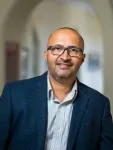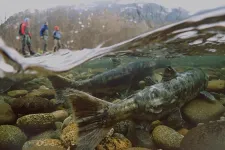(Press-News.org) Many ocular diseases involve changes in the structure and function of different regions of the back of the eye, also known as the “eye fundus.” For example, fluorescent pigments and tiny yellowish deposits called drusen accumulate under the retina in age-related macular degeneration, and the degeneration of neurons called ganglion cells is a defining characteristic of glaucoma. Interestingly, changes in the eye fundus are not restricted to vision-related diseases only. Certain neurological diseases like Parkinson’s and Alzheimer’s can cause changes in retinal nerves and blood flow.
In general, eye care professionals rely on color imaging and computed tomography techniques to diagnose ocular diseases. However, over the past few decades, scientists have found that disease-related changes in the eye fundus also modify its profiles for spectral reflectance and emittance. In other words, the way in which light interacts with specific retinal structures at different frequencies can provide important diagnostic information to complement standard imaging methods.
As a result, spectral analysis tools and techniques for light reflected or emitted by the eye fundus have steadily gained traction. Unfortunately, even though many different methods have been proposed, they still suffer from important limitations. One common issue is that most spectroscopy-based methods can only make measurements over a large region of the eye fundus, which hinders their ability to detect fine spectral changes in small retinal structures. On the other hand, techniques that can make localized spectral measurements require the fixation of the patient, which can be very tedious and uncomfortable.
To tackle these issues, a research team from Zilia Inc., Canada, led by Professor Dominic Sauvageau from University of Alberta, has developed a much more flexible system for targeted spectroscopy in the eye fundus. In their study, published in Journal of Biomedical Optics (JBO), they present the rationale behind their design and demonstrate its potential through a series of comprehensive experiments.
The proposed system has a handful of key features that make it stand out as a more versatile and flexible alternative to existing ones. The entire device has a series of optical elements that essentially allow three different light paths to and from the eye fundus to coexist without hampering each other. More specifically, illumination LEDs, a color camera, and a spectrometer can be used simultaneously to provide continuous color imaging and spectral measurements.
Moreover, the spectrometer section of the device focuses an LED onto a small region of the eye fundus, and the position of this region can be adjusted using simple mechanical actuators to rotate the beam splitter feeding the camera and the spectrometer. “The user can select a target and move it to any location within the eye fundus region being imaged without any realignment or change of the fixation target while continuously receiving spectral information of the targeted sampled area,” highlights Sauvageau. This feature makes it easy to take spectral measurements from very specific anatomical structures, such as the optic nerve, the retina, leakage of blood, or fat deposits, or any type of lesion. Notably, the system can also be used to conduct fluorescence measurements by adjusting the illumination source, which extends its applicability to detect an even wider variety of biomarkers.
The research team confirmed the capabilities and performance of their system through both in vitro and in vivo experiments. The in vitro experiments involved targeting colored areas in a reference target with a grid-like pattern and taking spectral measurements of an eye model that simulated a macula, blood vessels, a foreign body, and the optic nerve. On the other hand, the in vivo measurements were performed on the retinas of eight healthy subjects, which exhibited differences in the spectral profiles of the optic nerve and the parafoveal region.
Taken together, the results of this study highlight the many advantages of the proposed design and could pave the way to better diagnostic protocols for eye diseases. “Targeted ocular spectroscopy has the potential to assess the presence of different chromophores and fluorophores, such as hemoglobin, oxyhemoglobin, melanin, and lipofuscin, associated with disease progression,” remarks Sauvageau. “This could open the door to changes in the way we diagnose and treat eye diseases, and targeted ocular spectroscopy could become an increasingly important tool in eye care in the coming years.”
For details, read the original Gold Open Access article by LaPointe et al., “Targeted spectroscopy in the eye fundus,” J. Biomed. Opt. 28(12), 126004 (2023), doi 10.1117/1.JBO.28.12.126004.
END
Toward more precise and flexible targeted spectroscopy measurements in the retina
Scientists develop a versatile imaging system that will help diagnose pathologies in the eye fundus
2023-12-15
ELSE PRESS RELEASES FROM THIS DATE:
UVA biomedical engineer unveils the dynamics of maternal immune responses
2023-12-15
Sepideh Dolatshahi, an assistant professor of biomedical engineering at the University of Virginia, is spearheading an exploration of systems immunology in its crucial development phase — during pregnancy.
Systems immunology is about unraveling concealed patterns within the human immune system, said Dolatshahi, whose approaches to her research span computational modeling, systems serology and cutting-edge spatial analysis techniques to investigate immune interactions between mother and fetus during pregnancy that could later support early childhood immunity.
Designing Tailored and Effective Vaccine Plans
Babies are immunocompromised ...
Novel therapeutic target overcomes resistance to radiation therapy
2023-12-15
A new study finds that radiation therapy (RT) suppresses a key protein called bone morphogenetic protein and activin membrane-bound inhibitor (BAMBI) and activates immune suppressive cells. These effects dampen the capacity of cancer-fighting immune cells and decrease the effectiveness of radiation, inducing therapy resistance in cancer patients, according to a paper published December 15, 2023 in the Journal of Clinical Investigation.
Radiation therapy is a common cancer treatment that kills cancer cells and activates immune cells to fight cancer. Yet this process also ...
Understanding atmospheric flash droughts in the Caribbean
2023-12-15
The word “drought” typically conjures images of parched soil, dust-swept prairies, depleted reservoirs, and dry creek beds, all the result of weeks or seasons of persistently dry atmospheric conditions.
In the sun-soaked islands in the Caribbean, however, drought conditions can occur much more rapidly, with warning signs appearing too late for mediation strategies to limit agriculture losses or prevent stresses on infrastructure systems that provide clean water to communities.
Such occurrences – known as flash droughts – are the focus of a new paper authored by Assistant Professor Craig Ramseyer of the College of Natural Resources ...
Pesticides and adjuvants disrupt honey bee’s sense of smell
2023-12-15
It has long been known that exposure to pesticide sprays is harmful to honey bees. In a new study, researchers have uncovered the effect of such sprays on the sense of smell in bees, which could disrupt their social signals.
Honey bees live in dynamic communities and constantly communicate with each other using chemicals that serve as social cues. For example, nurse bees—that are responsible for taking care of larvae that ultimately become queens and worker bees—constantly monitor the ...
Immune cells shape lung before birth and provide new avenues for treating respiratory diseases
2023-12-15
Immune cells play an active and intimate role in directing the growth of human lung tissue during development, researchers find, revolutionising our understanding of early lung development and the role of immune cells outside of immunity.
The research offers new insights for understanding and treating respiratory conditions, such as chronic obstructive pulmonary disease (COPD). Respiratory conditions account for almost 20 per cent of all deaths in children under five years worldwide1.
The work reveals a surprising coordination between the immune and respiratory systems, much earlier in development than previously thought. This discovery raises questions about the ...
Rembrandt broke new ground with lead-based impregnation of canvas for The Night Watch
2023-12-15
New research has revealed that Rembrandt impregnated the canvas for his famous 1642 militia painting ‘The Night Watch’ with a lead-containing substance even before applying the first ground layer. Such lead-based impregnation has never before been observed with Rembrandt or his contemporaries. The discovery, published today in Science Advances, underlines Rembrandt's inventive way of working, in which he did not shy away from using new techniques.
The surprising observation is yet another result from Operation Night Watch, the largest and most wide-ranging research and conservation project in the history ...
SFU and UBC researchers receive $1.25 million to study cumulative effects on B.C. salmon
2023-12-15
Salmon researchers from British Columbia are embarking on a three-year study to understand and help mitigate the cumulative threats affecting the vulnerable species in the province’s watersheds.
The Watershed Futures Initiative, which includes researchers from Simon Fraser University, University of British Columbia and University of Montana, has received $1.25 million from the federal and provincial governments – through the joint British Columbia Salmon Restoration and Innovation Fund – to tackle the combined impacts of logging, mining, urban development, agriculture, climate change and other factors on salmon.
While ...
Endocrine-disrupting chemicals found in menstrual products including tampons, pads, and liners
2023-12-15
The average menstruator will use over 11,000 tampons or sanitary pads in their lifetime. Vaginal and vulvar tissue that touch pads and tampons is highly permeable. Through this permeable tissue chemicals are absorbed without being metabolized, which makes endocrine-disrupting chemicals potentially dangerous when found in menstrual products. Endocrine-disrupting chemicals can interfere with human hormones and cause medical issues, including gynecological conditions such as endometriosis and uterine fibroids.
Joanna Marroquin, a Mason PhD in Public Health student, and Associate ...
Five researchers named Argonne Distinguished Fellows for 2023
2023-12-15
The U.S. Department of Energy’s (DOE) Argonne National Laboratory has named five highly accomplished scientists as Argonne Distinguished Fellows in 2023. They are Glenn Decker, Paul Fenter, Robert Fischetti, Sven Leyffer and Valentine Novosad.
The honor recognizes scientists who have not only achieved international esteem but who have also demonstrated exceptional achievements in science or engineering relevant to Argonne’s core missions. They are leaders of major, complex, high-priority projects or programs that have an impact on the future of the Laboratory. Only a small ...
Study shows exposure to household chemicals can lower odds of getting pregnant
2023-12-15
Exposure to phthalates, a group of plasticizing and solvent chemicals found in many household products, was linked to a lower probability of getting pregnant, but not to pregnancy loss, according to research by a University of Massachusetts Amherst environmental and reproductive epidemiologist.
The study, published this week in the journal Environmental Health Perspectives, also noted an association between preconception exposure to phthalates and changes in women’s reproductive hormones, as well as increased inflammation and oxidative stress.
“Phthalates ...
LAST 30 PRESS RELEASES:
Eye for trouble: Automated counting for chromosome issues under the microscope
The vast majority of US rivers lack any protections from human activities, new research finds
Ultrasound-responsive in situ antigen "nanocatchers" open a new paradigm for personalized tumor immunotherapy
Environmental “superbugs” in our rivers and soils: new one health review warns of growing antimicrobial resistance crisis
Triple threat in greenhouse farming: how heavy metals, microplastics, and antibiotic resistance genes unite to challenge sustainable food production
Earthworms turn manure into a powerful tool against antibiotic resistance
AI turns water into an early warning network for hidden biological pollutants
Hidden hotspots on “green” plastics: biodegradable and conventional plastics shape very different antibiotic resistance risks in river microbiomes
Engineered biochar enzyme system clears toxic phenolic acids and restores pepper seed germination in continuous cropping soils
Retail therapy fail? Online shopping linked to stress, says study
How well-meaning allies can increase stress for marginalized people
Commercially viable biomanufacturing: designer yeast turns sugar into lucrative chemical 3-HP
Control valve discovered in gut’s plumbing system
George Mason University leads phase 2 clinical trial for pill to help maintain weight loss after GLP-1s
Hop to it: research from Shedd Aquarium tracks conch movement to set new conservation guidance
Weight loss drugs and bariatric surgery improve the body’s fat ‘balance:’ study
The Age of Fishes began with mass death
TB harnesses part of immune defense system to cause infection
Important new source of oxidation in the atmosphere found
A tug-of-war explains a decades-old question about how bacteria swim
Strengthened immune defense against cancer
Engineering the development of the pancreas
The Journal of Nuclear Medicine ahead-of-print tip sheet: Jan. 9, 2026
Mount Sinai researchers help create largest immune cell atlas of bone marrow in multiple myeloma patients
Why it is so hard to get started on an unpleasant task: Scientists identify a “motivation brake”
Body composition changes after bariatric surgery or treatment with GLP-1 receptor agonists
Targeted regulation of abortion providers laws and pregnancies conceived through fertility treatment
Press registration is now open for the 2026 ACMG Annual Clinical Genetics Meeting
Understanding sex-based differences and the role of bone morphogenetic protein signaling in Alzheimer’s disease
Breakthrough in thin-film electrolytes pushes solid oxide fuel cells forward
[Press-News.org] Toward more precise and flexible targeted spectroscopy measurements in the retinaScientists develop a versatile imaging system that will help diagnose pathologies in the eye fundus







